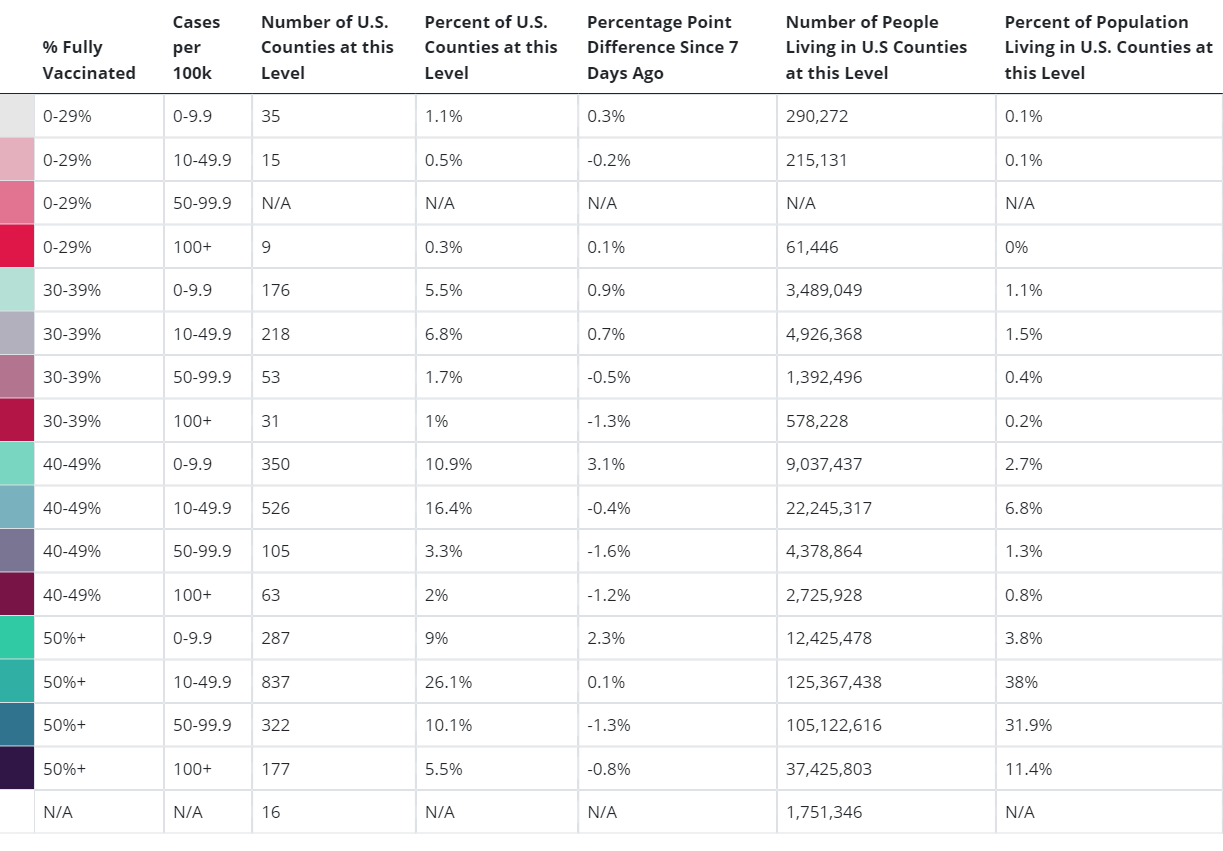
U.S. counties with the highest rates of vaccination against Covid are currently seeing more cases than those with the lowest vaccination rates, according to data published by the Centers for Disease Control and Prevention (CDC) earlier this week.
As appears from the table below, people who get vaccinated against Covid are actually more likely to get infected.

From top to bottom, the chart is listed according to the percentage of people in counties around the United States that are fully vaccinated. Around 280 million people are living in counties with a 50%+ vaccination rate, compared to around 50 million living in counties with lower vaccination rates.
According to an analysis done by The Epoch Times,
The 500 counties where 62 to 95 percent of the population has been vaccinated detected more than 75 cases per 100,000 residents on average in the past week. Meanwhile, the 500 counties where 11 to 40 percent of the population has been vaccinated averaged about 58 cases per 100,000 residents.
The outlet said that when comparing counties of similar populations, the ones with the most vaccinations tended to have higher case rates than those that reported the least vaccinations.
The analysis discovered that the smaller the population, the greater the difference in Covid cases between the most- and least-vaccinated counties:
Among counties with populations of 1 million or more, the 10 most vaccinated had a case rate more than 27 percent higher than the 10 least vaccinated. In counties with populations of 500,000 to 1 million, the 10 most vaccinated had a case rate almost 19 percent higher than the 10 least vaccinated.
In counties with populations of 200,000 to 500,000, the 10 most vaccinated had case rates around 55 percent higher than the 10 least vaccinated.
The difference was more than 200 percent for counties with populations of 100,000 to 200,000 (Emphasis added.)
As for the counties with an even smaller population, “the comparison becomes increasingly difficult because so much of the data is suppressed,” per the outlet.
One should also keep in mind that the CDC has been notorious for misrepresenting, withholding, or misreporting its own Covid data (see here, here, and here). As The Epoch Times points out, “The data is skewed by the fact that the CDC suppresses figures for counties with very low numbers of detected cases (one to nine) for privacy purposes.”
One could not help but see that if the vaccines worked as originally advertised and prevented infection, then there would be a huge number of people in the lower tiers of the “cases per 100k” categories, yet this is not the case. In fact, approximately 51 percent of cases per 100,000 residents occurred in counties where at least half of the residents are fully vaccinated. In other words, the vaccines seem to not work to prevent Covid.
At the beginning of the Covid vaccine rollout in March-April 2021, the American public was led to believe that the shots prevented infection.
The CDC published a study in March 2021 that found Pfizer-BioNTech and Moderna mRNA vaccines reduce the risk of infection by 90 percent two weeks after vaccination.
“These findings should offer hope to the millions of Americans receiving COVID-19 vaccines each day and to those who will have the opportunity to roll up their sleeves and get vaccinated in the weeks ahead. The authorized vaccines are the key tool that will help bring an end to this devastating pandemic,” said CDC Director Rochelle Walensky when announcing the findings.
“Our data from the CDC today suggests that vaccinated people do not carry the virus, don’t get sick,” she told MSNBC on March 30, 2021.
A couple of days later, however, the agency had to walk back Walensky’s claim by saying that “the evidence [wasn’t] clear” and that the director was “speaking broadly.”
In February 2021, President Joe Biden’s chief medical advisor, Dr. Anthony Fauci, implied that while there is a chance for fully vaccinated people to get infected, such people would carry a much smaller viral load, making them much less likely to spread the virus to others.
During a July 2021 CNN town hall, U.S. President Joe Biden stated, “You’re not going to get Covid if you have these vaccinations.”
Since then, all of the U.S. public health authorities have admitted that the vaccines’ efficacy is waning rather quickly, and the CDC now recommends that vaccinated people aged 12 and older take a booster at least five months after completing a primary vaccination series. Those who are 50 and older are recommended to take a third shot in the fourth month, and then the fourth, too, if one is immunocompromised.
According to the FDA, all Americans will likely need to take a fourth shot by the fall.
It seems rather confusing, to put it mildly, to see this kind of misleading messaging from the top U.S. authorities.
According to the Brownstone Institute, the vaccines were not even tested to prevent infection. Per the report,
Pivotal randomized control trials (RCTs) underpinning approval of Covid vaccines did not set out to, and did not, test if the vaccines prevent transmission of the SARS-CoV-2 virus. Nor did the trials test if the vaccines reduce mortality risk. A review of seven phase III trials, including those for Moderna, Pfizer/BioNTech and AstraZeneca vaccines, found the criterion the vaccines were trialled against was just reduced risk of Covid-19 symptoms.
All of that was published in August 2020 in The BMJ (formerly the British Medical Journal).
But what explains the higher infection numbers in the most-vaccinated counties?
According to some non-establishment doctors, Covid-19 shots cause so-called vaccine-acquired immunodeficiency syndrome (VAIDS). The syndrome weakens the immune system, which is responsible for protecting against all kinds of disease-causing pathogens and cancers. The damage accelerates with each additional booster, the doctors believe.
VAIDS might explain the disproportionate Covid rates among the vaccinated and unvaccinated, as well as the unprecedented excess mortality rate in 2021 in Americans aged 18-44.





